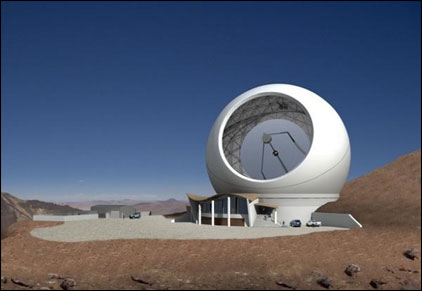 Image courtesy CCAT Image courtesy CCAT |
Artist's rendition of the 25-meter CCAT telescope planned to be
built high in Chile's Atacama Desert to view the formation of
galaxies, stars and planets. |
A $110 million telescope in Chile – planned in partnership with the University of Colorado at Boulder – that will probe distant galaxies and stellar nurseries has been named the top construction priority for mid-sized, ground-based telescopes by the National Research Council in the coming decade.
The 25-meter, far-infrared and submillimeter telescope effort involves two major partners – Cornell University and the California Institute of Technology – and three others: CU-Boulder and Canadian and German universities.
Known as CCAT, the facility would be built in the Atacama Desert in Chile at about 18,500 feet above sea level and would be the largest, most precise and highest astronomical facility of its kind in the world, said Associate Professor Jason Glenn, who is spearheading the CU-Boulder portion of the CCAT project.
The telescope was selected as part of the Astro2010 Decadal Survey produced by the National Research Council, an arm of the National Academy of Sciences. The council recommends priorities for the most important scientific and technical activities every 10 years in astronomy and astrophysics. The report, the "Astro2010 Decadal Survey: New Worlds, New Horizons in Astronomy and Astrophysics," was issued Aug. 13.
"With a broad scientific agenda, CCAT will enable studies of the evolution of galaxies across cosmic time, the formation of clusters of galaxies, the formation of stars in the Milky Way, the formation and evolution of planets, and the nature of objects in the outer solar system," according to the report.
"We are very excited about this selection because it means this telescope now has a very high probability of being built," said Glenn, a member of CU-Boulder's astrophysical and planetary sciences department. "This state-of-the-art facility will allow us to look back in time to when galaxies first appeared in the universe."
The Astro2010 committee is recommending that the National Science Foundation provide one-third of the cost of the project. The CCAT project partners also are raising money for the telescope, some of which already has been gathered through private donations and university contributions.
CCAT fundraising by CU-Boulder is under way and will require roughly $5.5 million in capital toward the cost of the facility, as well as a contribution toward future annual operating costs, said Glenn.
Technology for the CCAT telescope's instruments already is being developed at CU-Boulder. Glenn's lab at the Center for Astrophysics and Space Astronomy is building a state-of-the-art camera using an array of 2,400 superconducting detectors. CU-Boulder is collaborating with the California Institute of Technology on the effort.
CCAT will gather radiation from submillimeter wavelengths, which are longer than visible and infrared light but shorter than radio waves, Glenn said. The telescope would be a workhorse for astronomers, because about half of the light emanating from distant stars and galaxies reaches Earth at far-infrared and submillimeter wavelengths.
"This facility will enable us to study the earliest stages of star and galaxy formation, as well as the initial conditions of solar systems like our own," Glenn said.
A number of CASA faculty and students will be involved in the CCAT effort. Professor Jack Burns is serving as chairman of the CCAT board of directors. Other faculty members from CASA include John Bally, Jeremy Darling, Nils Halverson, Dick McCray and Michael Shull.

|
|
|